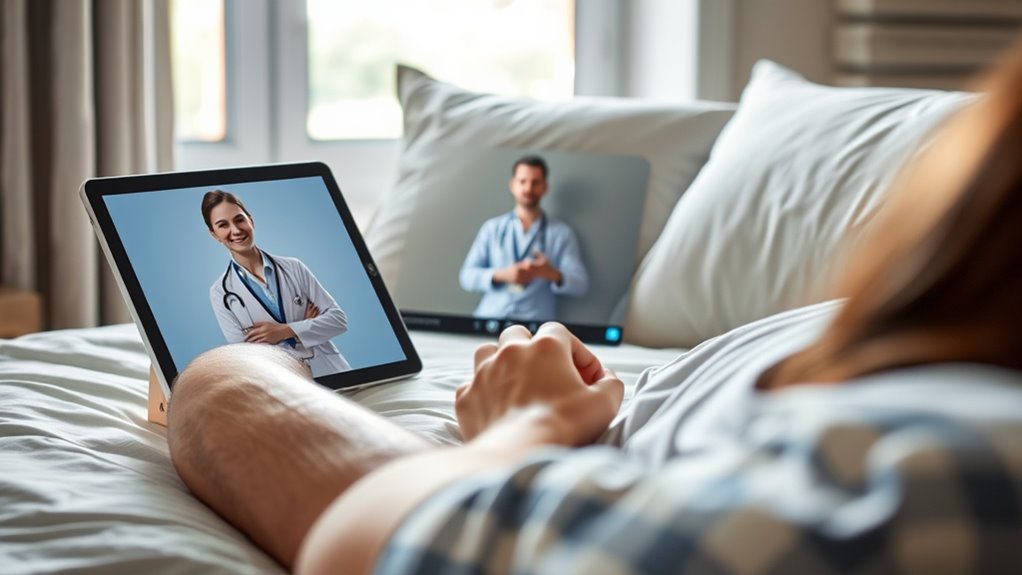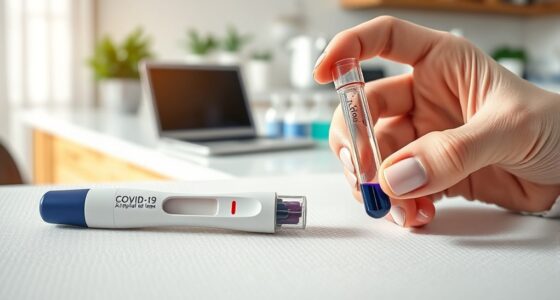Via telehealth, you can discuss your medical history and symptoms, allowing your provider to understand your condition remotely. Visual inspections of your appearance, posture, and movements help identify signs of illness or distress. You may also use devices like blood pressure cuffs or wearables to monitor essential signs at home. Guided self-examinations can be performed with instructions, but some assessments still require in-person care. Keep exploring to discover how technology is shaping remote medical evaluations.
Key Takeaways
- Medical history and symptom assessment can be conducted through open-ended questions and clarification via video or phone calls.
- Visual inspection of appearance, posture, and movements provides valuable clues for remote evaluation.
- Remote monitoring of vital signs is possible with digital devices like blood pressure cuffs and pulse oximeters.
- Guided self-examinations help patients assess specific areas under provider instructions.
- Limitations exist for tactile assessments, auscultation, and complex physical exams, which often require in-person visits.
Assessing Medical History and Symptoms Remotely
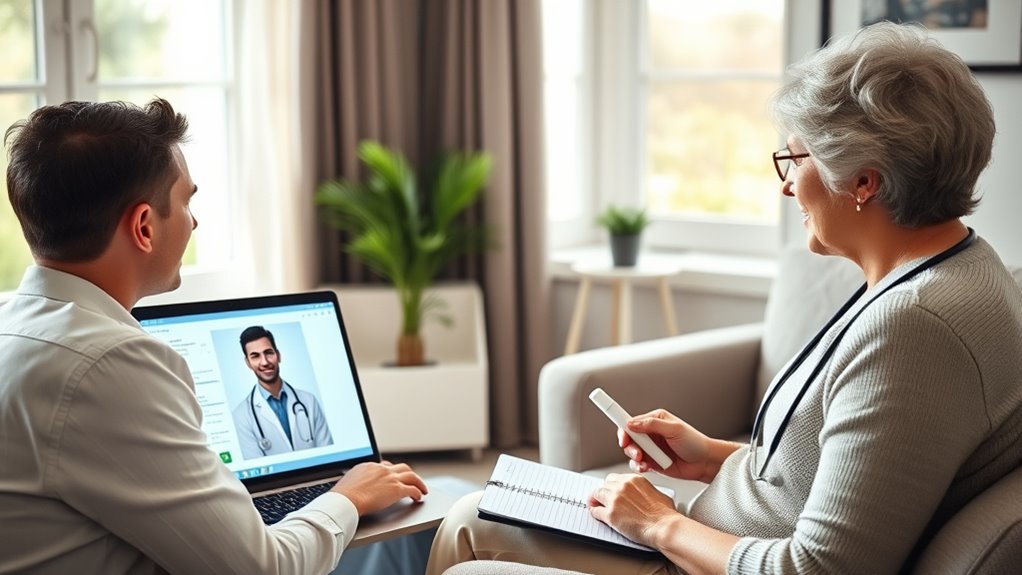
When evaluating medical history and symptoms remotely, effective communication is essential. You need to ask clear, specific questions to gather accurate information. Start by confirming basic details like your patient’s age, medical background, and current medications. Use open-ended questions to encourage detailed responses about their symptoms, such as onset, duration, intensity, and any factors that worsen or relieve them. Pay attention to tone and phrasing to ensure understanding, and clarify ambiguous answers. Active listening helps you pick up subtle cues that might inform your assessment. Summarize their responses periodically to confirm accuracy. Remember, without physical cues, your questions and responses must be precise. Good communication builds trust and provides the necessary information to make informed decisions about their care remotely. Additionally, understanding blood flow and circulation can enhance your interpretation of symptoms.
Visual Inspection and Observation Techniques
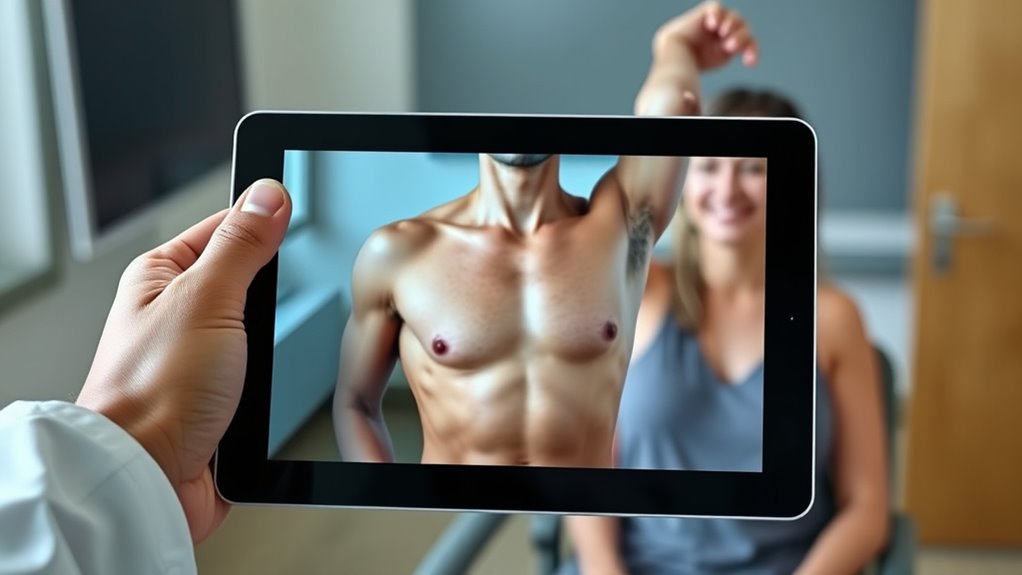
Visual inspection and observation are essential components of telehealth assessments, allowing you to gather critical information without physical contact. You should start by carefully examining the patient’s appearance, posture, and movements. Look for signs of distress, swelling, skin changes, or asymmetry. Observe facial expressions and eye contact, which can reveal emotional or neurological issues. Pay attention to gait, coordination, and any visible abnormalities. Ensure good lighting and ask the patient to position themselves in a well-lit area for better visibility. Use your observation skills to detect subtle cues that might indicate underlying health problems. Clear communication is key—prompt the patient to adjust their position or lighting if needed. Incorporating diverse designs and materials into your observation can help identify environmental factors affecting health. Your keen eye and attentive observation can substantially enhance remote assessments.
Using Technology for Remote Monitoring of Vital Signs
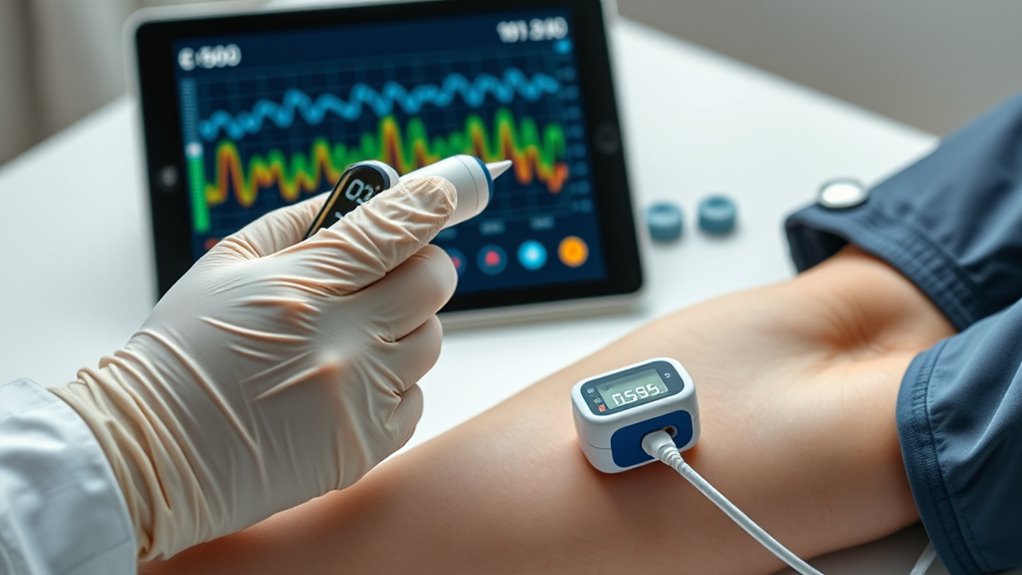
Using technology for remote monitoring of vital signs enables you to gather essential health data accurately and efficiently from a distance. Devices like digital blood pressure cuffs, pulse oximeters, and wearable fitness trackers allow you to measure heart rate, oxygen levels, blood pressure, and temperature without in-person visits. These tools transmit data directly to healthcare providers, ensuring real-time updates and prompt responses. You can monitor trends over time, helping to detect changes early. Many devices are user-friendly, requiring minimal technical skills, and often come with apps that guide you through proper usage. By integrating these technologies into telehealth visits, you enhance the quality of care, reduce unnecessary trips to the clinic, and support ongoing health management from the comfort of your home. Proper device maintenance ensures continued accuracy and reliability of your health data.
Conducting Guided Self-Examinations
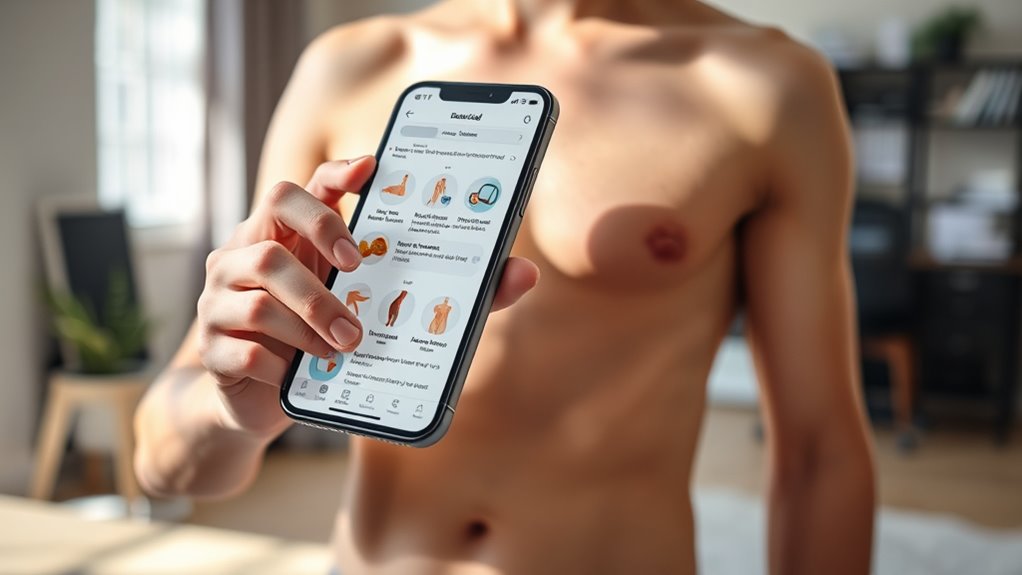
How can you effectively perform self-examinations during a telehealth visit? First, follow your provider’s clear instructions carefully. They may guide you to position your camera to get the best view, or ask you to touch or manipulate specific areas. Use good lighting and keep your hands steady. Pay attention to sensations, pain, swelling, or changes, and communicate what you notice. Take your time to ensure thoroughness, and don’t hesitate to ask your provider questions if something isn’t clear. Sometimes, your provider may ask you to perform specific movements or examine certain parts of your body. Remember, their guidance is designed to help you accurately report your condition, so stay attentive and detail-oriented throughout the process. Be aware that self-awareness is a key aspect of successful remote examinations, helping you recognize symptoms more accurately before your consultation.
The Role of Mobile Apps and Wearable Devices
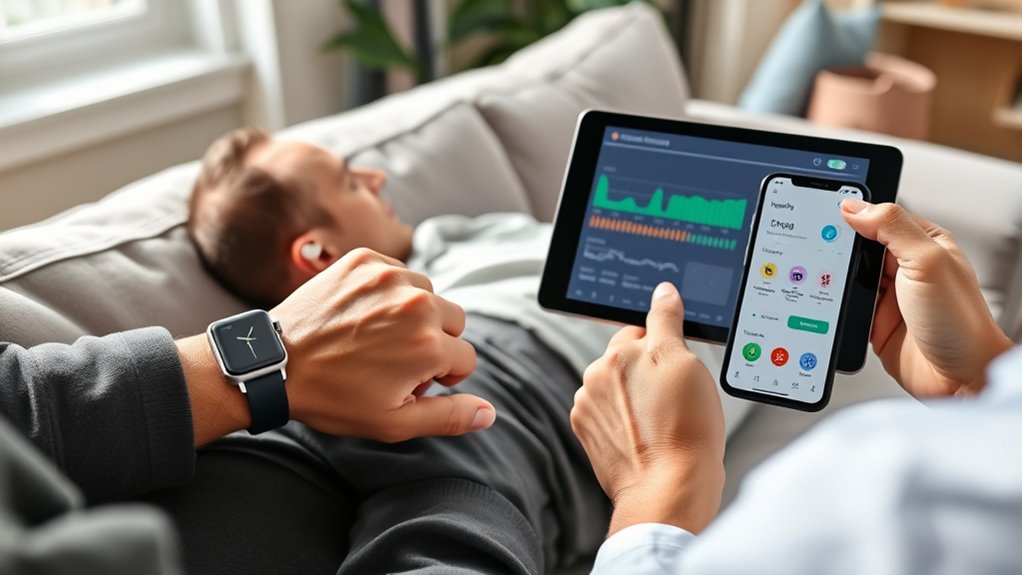
Have you considered how mobile apps and wearable devices can enhance your telehealth physical exams? These tools enable real-time monitoring of essential signs, activity levels, and other health metrics, providing your healthcare provider with valuable data without an in-person visit. Wearables like smartwatches and fitness trackers can track heart rate, sleep patterns, and even oxygen saturation, offering insights that support accurate assessments. Mobile apps can facilitate symptom tracking, medication adherence, and visual examinations through photos or videos. By integrating these technologies into your telehealth visits, you help your provider make more informed decisions quickly. This seamless data collection not only increases the precision of remote evaluations but also promotes proactive management of your health, making telehealth more effective and personalized. Real-time health monitoring is an increasingly vital component of remote healthcare, allowing for continuous oversight that can alert both patients and providers to potential issues before they escalate.
Limitations of Remote Physical Assessments
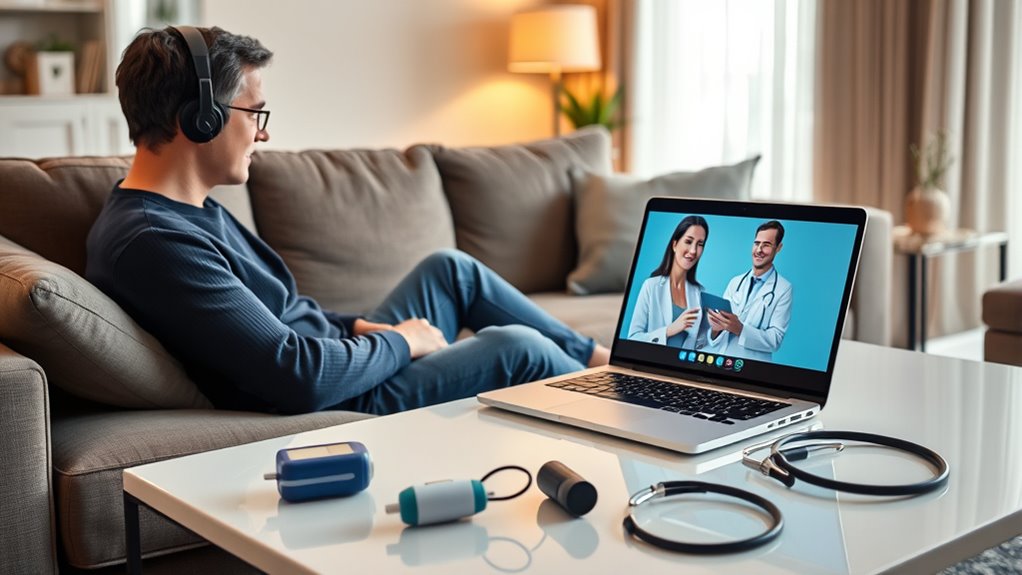
While telehealth offers many conveniences, it can’t fully replace the insight gained from in-person physical exams. You might miss subtle signs like skin texture changes, small swelling, or muscle tone variations that are easier to detect face-to-face. Remote assessments rely heavily on patient-reported symptoms and visual cues, which can be limited by camera quality and lighting. You can’t perform hands-on tests like palpation, reflex checks, or auscultation, which are often essential for accurate diagnosis. Additionally, complex conditions may require physical manipulation or specialized equipment unavailable remotely. These limitations mean that some health issues remain challenging to evaluate accurately without direct contact, emphasizing that telehealth is a valuable tool but not a complete substitute for traditional physical examinations. Fostering a digital-friendly environment at home can help improve remote assessment accuracy by ensuring good lighting and camera setup.
Situations That Require In-Person Evaluation

There are times when a remote exam simply isn’t sufficient, especially with urgent or complex health issues. Physical examination limitations can prevent accurate assessments, making in-person visits essential. Recognizing these situations helps ensure you get the proper care when it matters most. For example, some conditions require a hands-on assessment to properly evaluate the situation.
Physical Examination Limitations
Certain clinical situations require in-person evaluations because telehealth cannot fully capture the nuances of a physical exam. For example, appraising joint stability, muscle strength, or subtle skin changes often demands hands-on techniques. You can’t replace palpation, percussion, or auscultation with a screen. When precise measurements, such as reflex testing or detailed neurological exams, are needed, an in-office visit is essential. Visual inspection via video may miss small but significant signs like skin lesions or swelling. Additionally, evaluating complex pain responses or performing certain diagnostic tests requires physical contact. If your condition involves these limitations, your healthcare provider will advise an in-person assessment to ensure accurate diagnosis and appropriate treatment. Interior spaces can also influence the effectiveness of telehealth, affecting lighting and visibility during examinations. Telehealth serves well for many cases but isn’t suited for all physical examinations.
Urgent and Complex Cases
When a health emergency arises or when complex medical conditions are involved, in-person evaluation becomes critical. You need to see a healthcare professional face-to-face to accurately assess symptoms, conduct thorough examinations, and perform necessary tests. Telehealth cannot substitute the tactile feedback, detailed physical assessments, and immediate interventions required in urgent or complicated cases. Conditions like severe chest pain, difficulty breathing, neurological deficits, or suspected infections demand swift in-person attention to prevent serious complications. Relying solely on remote consultations in these situations risks misdiagnosis, delayed treatment, and worsening health outcomes. Recognizing when an in-person visit is essential ensures you get the proper care promptly, reducing risks and improving your chances for effective treatment. Always prioritize in-person care for urgent or complex health concerns. High-quality physical exams are vital for accurate diagnosis and effective treatment planning in these scenarios.
Future Developments in Telehealth Physical Exams
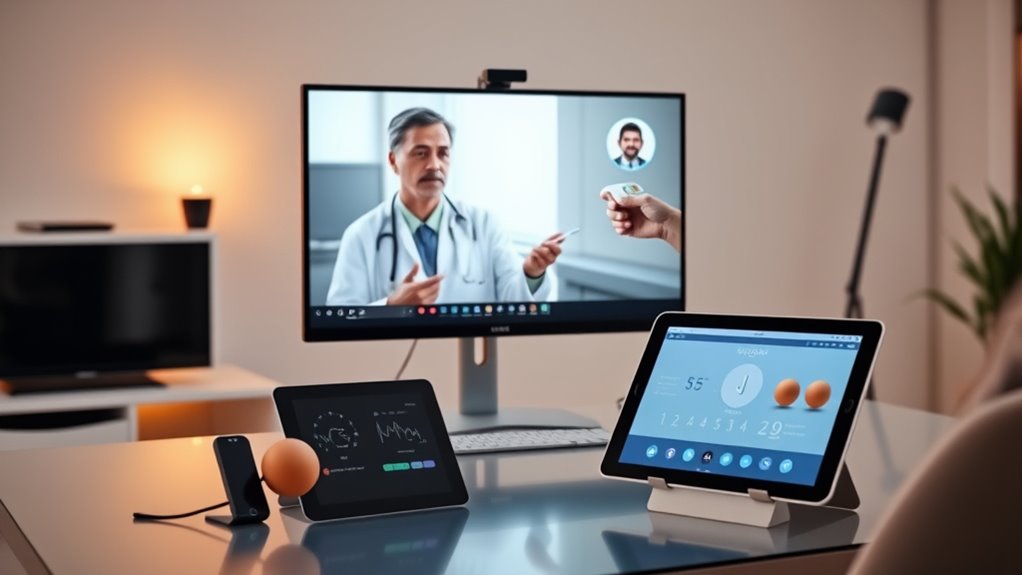
Advancements in technology are rapidly transforming telehealth physical exams, promising more thorough and accurate assessments in the future. You’ll likely see increased use of wearable devices that monitor vital signs, movement, and other health metrics in real time. Artificial intelligence will play a bigger role, analyzing data instantly to identify issues and guide diagnostics. High-resolution cameras and improved audio will enhance remote examinations, allowing you to perform detailed visual and auditory checks. Augmented reality (AR) and virtual reality (VR) may help simulate in-person assessments, offering immersive experiences for both providers and patients. As these technologies evolve, you’ll benefit from more precise evaluations, faster diagnoses, and personalized treatment plans—all from the comfort of your home. Additionally, innovations in remote diagnostic tools are expected to further expand the scope and accuracy of telehealth physical exams. The future of telehealth physical exams is set to become more extensive and reliable than ever before.
Frequently Asked Questions
Can Remote Exams Replace All In-Person Physical Assessments?
You wonder if remote exams can fully replace in-person assessments. While telehealth can handle many evaluations like visual inspections, history-taking, and some basic tests, it can’t replicate hands-on exams, palpation, or certain diagnostic procedures. You benefit from convenience and quick access, but for complex or detailed assessments, in-person visits are still essential. Remote exams are a valuable tool, yet they complement rather than entirely replace traditional physical assessments.
How Do Telehealth Exams Handle Complex or Urgent Conditions?
Did you know that around 80% of urgent care visits can be managed remotely? When it comes to complex or urgent conditions, telehealth exams often involve detailed virtual assessments, real-time video, and remote monitoring devices. You might be directed to seek immediate in-person care if symptoms are severe or unclear. Telehealth is a valuable tool, but it’s essential to recognize its limits and prioritize safety for urgent health issues.
Are There Privacy Concerns With Remote Physical Exams?
You might wonder if remote physical exams raise privacy concerns. While telehealth platforms use encryption to protect your data, there’s always a risk of breaches or unauthorized access. You should verify you’re using secure, trusted services and perform exams in private settings. It’s also important to read privacy policies and understand how your information is stored and shared, so you can confidently participate in remote healthcare without compromising your privacy.
What Training Is Needed for Clinicians to Perform Remote Exams Effectively?
You need specific training to perform remote exams effectively. Focus on developing your communication skills to gather accurate information and guide patients through self-examinations. Learn how to operate telehealth technology confidently, ensuring clear video and audio quality. Understanding privacy protocols and legal considerations is essential. Additionally, stay updated on best practices for remote assessment. This combination of technical, communication, and legal knowledge helps you deliver high-quality care remotely.
How Accurate Are Remote Assessments Compared to In-Person Evaluations?
You might think remote assessments are just a rough sketch, but they can be surprisingly accurate—sometimes even more precise than in-person exams! With the right tools and training, you can detect many health issues remotely, catching symptoms early and saving lives. While they may not replace every in-person visit, remote evaluations are rapidly closing the gap, making healthcare more accessible, efficient, and reliable than you ever imagined possible.
Conclusion
Think of telehealth physical exams as a bridge connecting you to healthcare from afar. While technology has expanded your reach, it’s not a complete map—some destinations still need a personal visit. Embrace the tools available, but remember, certain signs require in-person care. As technology advances, this bridge will grow stronger and wider, guiding you more confidently through your health journey. Until then, stay informed and know when to cross over for a hands-on assessment.
